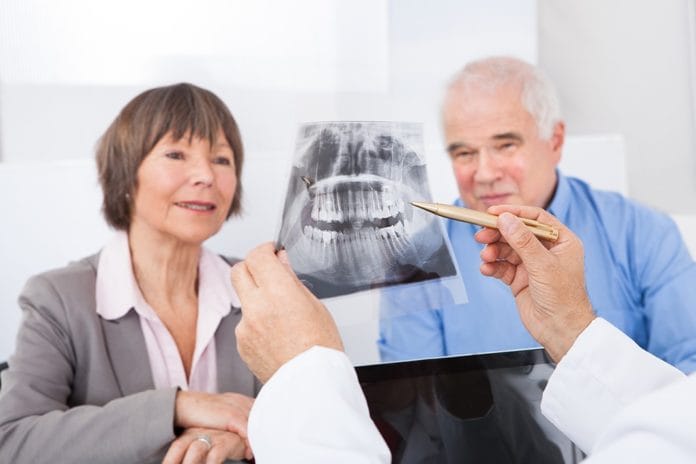According to the United States Census Bureau, by the year 2030, every baby boomer in the United States will be over the age of 651. Why is that fact important to us as Dental Hygienists? It is extremely significant, considering a ballooning geriatric population, 78 million by the year 2035 to be exact, will make up a significant portion of our patient population. We need to be prepared to handle this growing age group, along with their more complicated oral hygiene needs.
Geriatric patients usually present with multiple oral health needs and circumstances which are consistently different than their younger counterparts. For this reason, the way we treat these patients should be tailored to fit their more complex issues. Fortunately, a much smaller portion of aging adults are edentulous than in the past thanks to better preventative dental care, but that also means many more elderly patients will be seen regularly in the dental office than in past years.
What are some of the unique oral health needs and conditions presented by geriatric patients?
One of the first things that comes to mind for most hygienists when thinking about geriatric patients is Xerostomia. Dry mouth affects 30% of patients 65 and older and 40% of patients 80 and older2; it is one of the most prominent dental health concerns for the geriatric population. Xerostomia can lead to increased caries risk, gingival inflammation, mucositis, halitosis, and general discomfort for patients.
Xerostomia is most often a side effect of another factor affecting geriatric patient’s oral wellbeing, which is declining health and an increased need for medications. An increase in medical conditions means the geriatric population is taking more prescriptions daily than other cohorts, and therefore have more complications, such as xerostomia, as a result. Arthritis, heart disease, cancer, COPD, Alzheimer’s, diabetes, and osteoporosis are just some of the ailments afflicting many geriatric patients.
Unfortunately, many of these health conditions can lead to another oral health issue for geriatric patients, poor oral hygiene. Patients with arthritis may find their manual dexterity declining and brushing to be painful and difficult for them. Cancer and heart disease can cause severe fatigue, in some cases, and a lack of energy to complete basic oral hygiene. Alzheimer’s patients may have difficulty remembering to brush and floss or not know how. Often, caregivers have a hard time keeping up with the oral hygiene needs of their dependents.
To add to the complications, 70% of people over the age of 65 have periodontitis, according to the American Academy of Periodontology3. By its nature, periodontal disease is a chronic condition needing constant maintenance to stabilize, and the factors listed above only make this more difficult for geriatric patients. In addition, exposed root surfaces from bone loss can leave patients vulnerable to root caries, which can be even more exacerbated by xerostomia.
Tooth loss from periodontal disease over time can mean older patients have more prosthetic appliances, fixed and removable, than their younger counterparts. Missing teeth, bridges, partial dentures, and full dentures can make oral hygiene more challenging. They can also hinder chewing function, contributing to nutritional deficiencies.
How can we tailor dental care to meet these needs?
Whew, it sure sounds like we have our work cut out for us when assessing the dental needs of our geriatric population! Luckily there are a lot of ways for us, as dental hygienists, to address these issues and really help our patients.
For starters, it’s important for us to take our time when seeing geriatric patients. Ensuring we aren’t rushed when treating these patients will allow for proper identification of oral health needs and the time needed to treat them. For the most part, older patients prefer a slower appointment pace. They tend to take a little longer for patient positioning and often enjoy more social interaction than the busier younger generations. Older adults will usually have more complex medical histories and oral health considerations that naturally take longer to assess.
When communicating with our older patients, it is sometimes necessary to speak more slowly, clearly, and if needed, loudly, but to also ensure that we do not have a condescending tone. Having head pillows and blankets on hand is always helpful as well. The physical and mental functioning of elderly patients can vary widely from one individual to the next and should be something you are constantly assessing when tailoring your treatment, communication, and home care instructions for each patient.
Essentially, you will need the extra time to assess the “big picture” because addressing the oral health needs of geriatric patients can sometimes feel like putting together a jigsaw puzzle. You need to have all of the pieces before you can start to put the puzzle together.
For example, when assessing a patient with xerostomia, salivary replacement products should be recommended, but we should also be examining all of the other pieces to our puzzle. Is the patient getting enough fluoride to prevent tooth decay? Are they sucking on candies with sugar to increase salivary flow and unknowingly causing tooth decay? Are they drinking enough water? Are they able to effectively clean their own teeth, and are they using the best oral hygiene tools for their level of functioning? The pieces of the puzzle can add up quickly when assessing the needs of geriatric patients and are made more complex with each condition presented.
Another way we can tailor our treatment to meet the needs of our geriatric patients better is to make sure we take caregivers into consideration. Whether it be relatives or care home staff members, caregivers play an important role in the oral health of many elderly patients. If necessary, we should be including caregivers in the oral hygiene instructions and stressing the importance of regular dental visits to them as well. If caregivers understand the importance of these things, they can become allies for us in the treatment and prevention of oral diseases in our geriatric patients. It may be helpful to distribute instructional pamphlets to caregivers or even organize instructional seminars at local care homes and assisted living facilities.
Unfortunately, not all of our geriatric patients have caregivers to rely on. These patients may require special consideration when assessing home care. Sometimes modifications we don’t often think about are necessary to help patients maintain their oral health. For example, for many geriatric patients, arthritis can lead to pain in their hands and difficulty with manual dexterity. You may need to suggest an electric toothbrush, which can be easier to grip, or a modified manual brush; handles similar to a bicycle handle which can be slipped over the handle of a manual toothbrush are available online and at many drugstores. Proxabrushes and water flossers are also great recommendations for interdental cleaning for geriatric patients.
I am also a strong believer that fluoride treatments, both in office and at home, should be a priority when treating all senior patients. Benjamin Franklin’s quote, “An ounce of prevention is worth a pound of cure,” certainly applies here, and should be at the forefront of our minds when treating our geriatric patients.
Obviously, the treatment of geriatric patients can be a widely varying and complex task. Hopefully, by carefully assessing each of our geriatric patients and putting together all of the “puzzle pieces,” we can tailor our care to meet the unique needs of this growing population.
Before you leave, check out the Today’s RDH self-study CE courses. All courses are peer-reviewed and non-sponsored to focus solely on high-quality education. Click here now.
Listen to the Today’s RDH Dental Hygiene Podcast Below:
SEE ALSO: Considerations for the Management of Geriatric Patients
DON’T MISS: New AAP Periodontal Classification Guidelines for 2018
References
- “Older People Projected to Outnumber Children for First Time in U.S. History.” United States Census Bureau, 6 Sept. 2018, census.gov/newsroom/press-releases/2018/cb18-41-population-projections.html.
- “Aging and Dental Health.” American Dental Association, 2 Jan. 2018, ada.org/en/member-center/oral-health-topics/aging-and-dental-health.
- “Gum Disease Risk Factors.” American Academy of Periodontology, 2018, perio.org/consumer/gum-disease-risk-factors.










